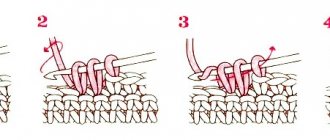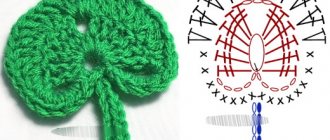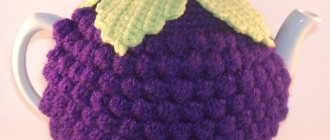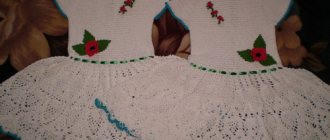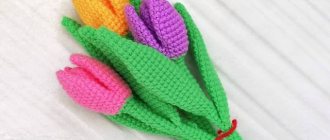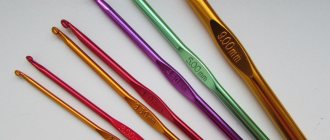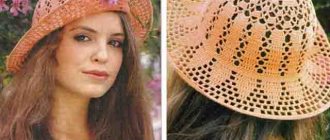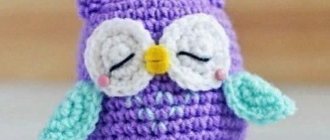Warm knitted socks for beginner craftswomen
For work we will need:
- yarn (48% wool, 52% acrylic, 100 grams per 200 meters);
- hook number 3.
Description of work
Toe
Knitting begins with the toe: crochet 10 stitches. p. + 1 v. p.p.. Next we knit s. without n. in the 2nd and all subsequent c. n. = 10 s. without n..
We adhere to the given toe knitting pattern:
On the other side of the chain we do another 10 s. without n. and we get a circular row consisting of 20 s. without n..
We mark two side loops with contrasting threads and get 8 stitches between them. The sock is knitted in a spiral without a stitch. p.p..
Starting from the 2nd row, we perform additions (indicated by “birds”): we perform an increase in the marked paragraph, 8 s. without n., 2 additions (one in each of the marked loops), again 8 s. without n., addition to note. loop = 24 p..
We knit the third row like this: 2 s. without n., 1 addition, 8 p. without n., 1 addition, 2 p. without n., 1 addition = 28 p..
Fourth row: on the smaller side of the oval between increments of 4 s. without n., on the long side 8 s. without n. = 32 p..
Fifth row: on the smaller side of the oval, perform 6 s between increments. without n., along the length – 8 s. without n. = 36 p..
Sixth row: on the smaller side of the oval, perform 8 seconds between increments. without n., but the length is still the same 8 s. without n. = 40 p..
Main part
In the seventh row and subsequent ones, we will begin to alternate the colors of the threads: we knit the beginning of the row with an emerald thread, and in the middle of the long side of the oval we replace the color of the threads with light green and knit a row of 1 s. without n. in each stitch of the previous row. At this stage, you can remove the contrasting thread markers.
7-13 pp: p. without n. = 40 p..
In the place where at 6 p.m. we knitted increases, we knit increases in 14 p., in total - 4 increases = 44 p..
15 r.: p. without n..
16 rubles: again in place of the additions in 14 rubles, we knit out the increases and in 16 rubles. = 48 p. The workpiece should be tried on while working. If you have narrow feet, you may not need an increase.
Next we knit about 15 rows of 1 s. without n. in each stitch of the previous row. The number of rows may vary depending on your size
Heel
Next, we continue to work not in circular rows, but in straight and reverse rows, i.e., in a straight line. For the heel we will select 22 stitches and we will knit it with a thread of the same color (light green).
So, we knit 11 stitches in green, then another 11 stitches in light green, turn the work and skip the 1st stitch, then 21 s. without n..
We turn the work again and knit, starting from the 2nd p., 20 s. without n..
We continue in the same way for another 22 rows: skip the 1st stitch of each new row, then knit (n – 1 stitch), where n is the number of stitches in the previous row. R. and we get a heel in the form of a triangle.
Again we begin circular knitting with light green thread: 22 loops on one side of the heel, then 13 s. without n. along the top of the sock, 1 increase, 12 s. without n. and again 22 p. heels.
Change the thread colors again. To make it more convenient for us, we suggest numbering the rows and counting the previous one as the first of them.
2 r.: in the middle of each side of the heel we make a decrease, that is, we knit 10 s. without n., decrease, then in a circle to the same place on the opposite side, decrease again.
3 p.: in a circle for 1 s. without n..
4 rubles: decreases at the same level.
5 rubles: in a circle p. without n..
6 rows: decrease in the middle of each side of the heel.
7 rows: we form a notch on the back side of the heel: at the top of the triangle we perform 1 decrease, after which s. without n. to the end of the row.
8 rows: we knit a decrease in the middle of each side of the heel and also perform 1 decrease in the middle of the top of the sock (in the place where we made an increase in the 1st row after knitting the heel).
9 rows: decrease at the very beginning of the row (continue to form the notch behind the heel), decrease in the middle of each side of the heel.
10 rubles: again we make decreases in the middle of each side.
11 p.: decrease in the center of the triangle, after which s. without n..
12 rubles: decrease in the middle of each side of the heel.
13 r.: decrease in the middle at the very beginning of the r..
RUR 14: same as RUR 12..
15 r.: p. without n. round.
16 r.: p. with n..
Rubber
2nd century p.p., yarn over, place the hook under the previous column. r., we seize slaves. thread and knit with. with n..
Now we yarn over the hook again and insert it in front of the trail. column previous r., we seize slaves. thread and knit with. with n..
As a result, we will get two half-columns: convex and concave. We alternate them until the end of the row.
In the new row we continue according to the same pattern: convex over convex, concave over concave. We continue to work until we reach the desired toe height.
The second sock is knitted in the same way.
Cropped knitted white socks for beginners
To knit white socks, we will need:
- yarn (100% mercerized cotton, 107 meters per 50 grams) about two skeins;
- hook number 3.
White crochet socks: description
We begin to knit the sock from the toe. We wrap the thread around our finger, into the ring we get, and knit 8 s. without n. and tighten the ring.
We knit in a spiral. knot, grabbing the stitch by the rear lobes and performing increases in this way:
1 p.: 2 s. without n. in each p. = 16 p.;
2 p.: *3 p. without n., in the words paragraph 3 p. without n.*, from * to * = 20 p.;
3 p.: *4 p. without n., in the words paragraph 2 p. without n.*, from * to * = 24 p.;
4 rubles: *2 s. without n., in the words paragraph 2 p. without n.*, from * to * = 32 p.;
5 p.: *3 p. without n., in the words paragraph 2 p. without n.*, from * to * = 40 p..
We knit 10 rows without increases.
After this, add loops on the sides of the toe in this way: 2 s. without n. in 1 p. previous. r., 19 p. without n., 2 p. without n. in 1 p., 19 p. without n. = 42 p..
We perform such increases x 3 more in each subsequent 5th row. = 48 p..
After this, you need to try on the sock and, if necessary, make additional decreases or increases.
Next, we knit straight until the length of the workpiece is equal to the foot to the heel (about 16-17 cm).
Now we start knitting the heel: we divide our work in two along the side edges and then continue knitting only the loops of the lower part of the foot - about 24 r. in straight rows: turn the knitting, knit for 24 s. without n. and turn again.
Then at the beginning of each row we leave 1 s without knitting. without n., until we get 12 s. without n.. We knit these 12 s. without n., after which we start increasing: at the beginning of each row, 1 p. until we get 24 s again. without n.. We continue to knit in a circle on all the loops of the base. knot another x 5 rubles, as usual, knitting the loops at their back segments.
We cut and fasten the thread, after which we sew the side seams of the heel.
Knitting instructions from toe
The toe is the part of the sock that covers the toes. This detailed master class describes the process of creating crochet socks, which starts from the toe:
The thread is wrapped around 2 fingers, a hook is placed under one thread, the second is grabbed, and pulled out with a loop, thereby forming an amigurumi ring. 6 air loops are knitted into it and the end of the thread is tightened.
In each loop of a closed ring, 2 single crochets are knitted. A total of 12 loops are formed in a circle.
The tail of the thread marks the beginning of the row. Knitting is done alternately: in the first loop - 1 single crochet, in the second - 2, etc.
In the next row, the alternation continues according to a different principle: in 1 and 2 loops - 1 column, in 3 - two, etc. In each subsequent row, the number of loops with 1 column increases by 1. There are 6 such alternating rows in total.
Next, the sole of the sock is formed from the toe to the heel. In a circle, single crochets are knitted into each loop.
The number of rows is 27.
Original jacquard socks for beginner knitters
In order to crochet socks, we will need:
- yarn (55% sheep wool, 20% silk, 25% polyamide, 200 meters per 50 grams) - one skein each in white, olive, terracotta and brown;
- hook No. 2.5.
Finished product dimensions: 38-39 (40-41) 42-43
Basic pattern: half-columns, with each circular row starting from 2nd inch. p. instead of the first half-column, and end with one connecting column in the upper v. p.. Starting from the second circular row, we turn the knitting in front of the new row.
Jacquard patterns A and B: the number of loops is a multiple of 4. We knit, adhering to the counting pattern A and B. We repeat the indicated loops. We knit the designated rows once at a time.
Knitting density, basis knot: 23 p. x 18 r. = 10 x 10 cm.
We adhere to Scheme 1, Scheme 2 and symbols:
Crochet socks: job description
We knit 8 half-stitches into the initial loop of terracotta-colored thread, complete the circular row with one connecting stitch in the first loop and knit 9 (9)1 10 circular rows for the toe, following pattern 1 = 44 (44) 48 p..
In the second circular row we double the number of stitches to 16 stitches.
From the third row in each corner. R. add 4 sts. From here we knit with knit and purl crochets. r., i.e. after the connecting stitch, turn the knitting. We need this in order not to shift and constantly maintain the beginning of the edge. R. in the middle of the sole, which we will knit later.
Next we proceed to knitting the base. knot..
After 4 (5) 6 cr. R. from main knot We begin to work, adhering to counting scheme A.
After 18 (19) 20.5 cm from the set, we add for the heel and wedge of lifting on both sides of both middle loops in each cr. R. 6 (6) 7 x 4 p. = 68 (68) 76 p..
After completing the counting pattern A, we continue working on all the loops with a white thread. After completing the increases for the heel wall, we knit 15 (15) 17 p. with olive thread in straight and reverse rows 19 (19) 21 r. adhering to scheme 2, attaching the heel wall to the canvas (as shown in photo 3) and for size 42-43 we repeat another x 1 17-17 pp..
Next, we knit the height of the sock with white thread, while in the first two cr. R. we carry out 20-21 rubles. following pattern 2 = 44 (44) 48 p..
After this, with the same white thread we knit 1 (2) 3 cr. p., then follow the counting scheme B. Having finished it, use a terracotta thread to make 1 cr. R. “crawfish step” (= s. without n. from left to right) and finish the work. The original crochet socks are ready!
We hope our lesson today will help you understand how to crochet socks. Of course, there are a huge number of models of socks: openwork and dense, with a simple pattern and with jacquard... A little later we will tell you about them, but for now we wish you even stitches and pleasant knitting!
Unusual women's socks: spiral knitting technique
To make thick winter socks, prepare in advance:
- yarn "Furlana" - 15 g;
- wool yarn – 150 g;
- hook number 3;
- circular knitting needles No. 10 for tying the finished product.
A detailed description of the technique of knitting women's socks with spirals:
- You need to start working with a chain chain of 6 points. Having tied it, close it into a ring.
- Next, knit st. b/n – 6 pcs.
- Continue working according to the diagram.
- Knit until the sock “grows” to the size you need, and then make a spiral without increasing. Tie an elastic band according to the pattern.
- To shift the pattern when moving to the floor stitches, skip 1 stitch in 2 spirals, and knit the next 3 stitches along the floor.
- Having knitted a sock of the required height, replace the penultimate half-column with a st. b/n, and the last one - on the connecting one.
- Fasten, cut and hide the thread.
- Take circular knitting needles and cast on 14 stitches along the edge of the product.
- Form 5 fluffy circular r. and close the loops.
